by Ian Skellern
Welcome to the 2019 edition of Quill & Pad’s early Grand Prix d’Horlogerie de Genève predictions in which the team picks favorites and explains why.
The panelists are:
Ian Skellern (IS), co-founder and technical director
Joshua Munchow (JM), resident nerd writer
Martin Green (MG), resident gentleman
Sean Li (SL), editorial director of Blackbird Watch Manual
Tim Mosso (TM), watch specialist and media director of pre-owned watch retailer Watchbox
Note: as jury members, editor-in-chief Elizabeth Doerr and resident collector GaryG do not take part in these early predictions.
The GPHG foundation describes the Artistic Crafts category for watches entered as “watches demonstrating exceptional mastery of one or several artistic techniques such as enamelling, lacquering, engraving, guilloche (engine-turning), skeletonizing, etc.”
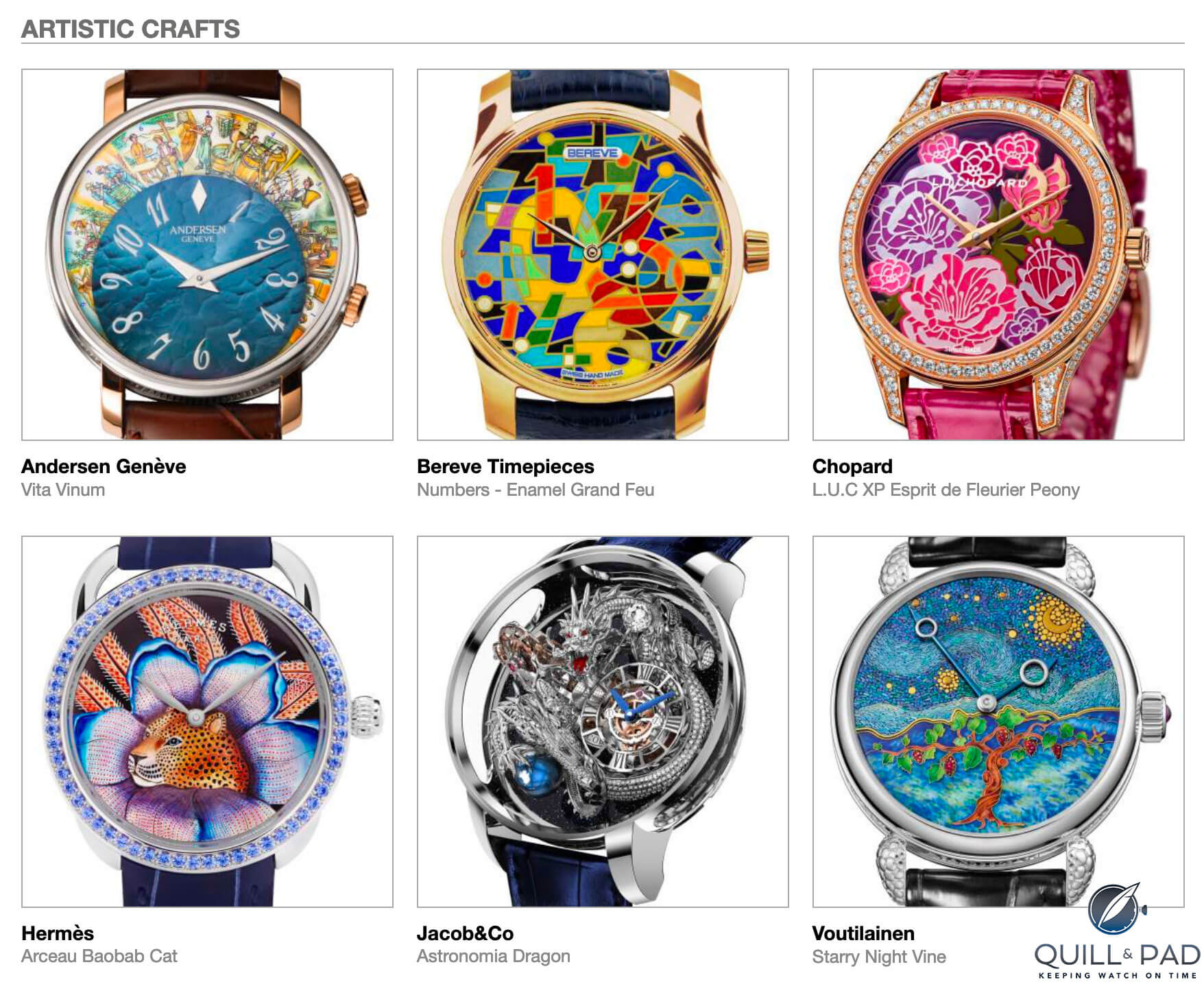
Shortlisted Artistic Crafts watches for the 2019 Grand Prix d’Horlogerie de Genève: (from top left) Andersen Genève Vita Vinum, Chopard L.U.C XP Esprit de Fleurier Peony, Hermès Arceau Baobab Cat, Jacob & Co Astronomia Dragon, Bereve Timepiece Numbers Enamel Grand Feu, Voutilainen Starry Night Vine
MG: Beauty is in the eye of the beholder, and that is most certainly the case in this category.
IS: I expressed my opinion in the Jewellery category that it was impossible to accurately judge those glittering timepieces without having handled them and examined the craftmanship with one’s own eye (and a good loupe). And that’s the same for the Artistic Crafts category. But what a sheer pleasure for the eyes and soul to examine these sensational watches and the art they highlight. Here the watches have to be judged on the quality and execution of the art, the watch itself, and the marriage of the two. All subjective. And then there’s an even more subjective filter: what makes each of us smile. I’d be surprised if we came to a consensus in this category, which usually guarantees that we will.
JM: The Artistic Crafts category is like the Men’s category to me, Ian: especially difficult to judge because we are trying to choose between expert craftsmanship in various forms and in designs that we may or may not enjoy. Based on the entries to this category, it is obvious that there are some awesomazing artists working for watch brands in Switzerland and around the world.
Choosing a favorite may come down to subjective taste and which watch wows you the most. I have one that stands out to me, but if pushed I could easily argue for every single piece in the category.
SL: This is another of the categories that is extremely subjective; the artistic crafts are something that we often talk about with these watches but can only evaluate based on personal aesthetic tastes. It’s also one where having the watches in hand is tremendously valuable. I’m probably going to come across rather oafish in my comments here.
TM: This category is a pure pleasure. All of the submissions are fresh, impressive, and worthy of consideration for the prize. Aside from personal style preference, the only real basis for judgment is the sense of awe inspired by each piece.
On that front, Kari Voutilainen and Jacob & Co. lead the pack – for me, at least – but each of these pre-selections is a coruscating statement of ability and imagination.
Andersen Genève Vita Vinum
SL: While I’m not much of a wine connoisseur, the fact that this watch is, in effect, a rotating fresco over 12 months, sets its artistic endeavors apart. Also, the fact that the case has been made traditionally, without any CNC machine, also highlights the traditional crafts involved in watchmaking. The blue dial seems a bit mismatched, though; not sure how it relates to the overall theme of the watch – perhaps it’s meant to represent a giant grape?
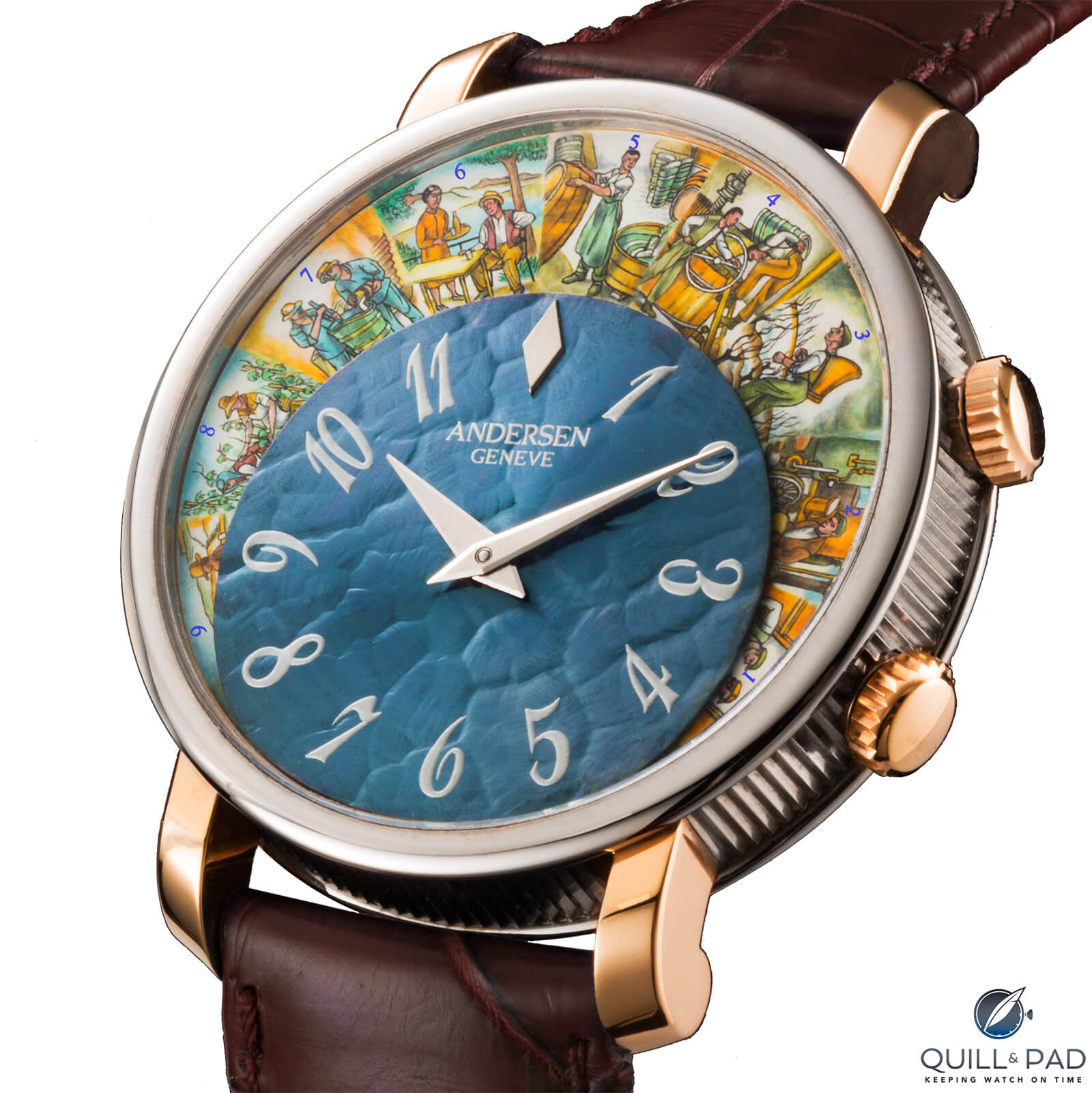
Andersen Genève Vita Vinum
TM: Andersen’s signature blue gold takes center stage on this dial, Sean, but the strength of the mini-cyclorama narrative is such that even a massive medallion of oddly tinted gold doesn’t overpower the underlying imagery. If there were a GPHG category expressly dedicated to miniature painting, the Andersen Vita Vinum would be the clear victor.
The Andersen Genève Vita Vinum boasts an impressive tandem of art and complication. The rotating one-year “wine cycle” production disk showcases the vintner’s process from grape to table, and all aspects of the miniature painting are flawless. I love the clever concept, and the execution is world class.
JM: I try to steer clear of ties, but in this case I have to say that both the Andersen Genève Vita Vinum and the Bereve Numbers are in a battle for third place in my book. The Andersen Genève Vita Vinum is a terrifically interesting take on a calendar watch using a 12-month disk to display the year-round steps for making great wine.
On a disk that rotates each day, there are 12 frames of miniature paintings depicting a vintner (winemaker) as he prepares his vineyard for the season, grows his grapes, harvests, makes wine, and begins again. The delicate images are remarkable for their hand-painted details, some requiring the use of a single brush hair for application. When combined with the unique guilloche on the 21-karat blue gold dial, this watch stands out as a very functional work of art. I think it falls short of the most spectacular artistic piece, but it makes a strong impression nonetheless.
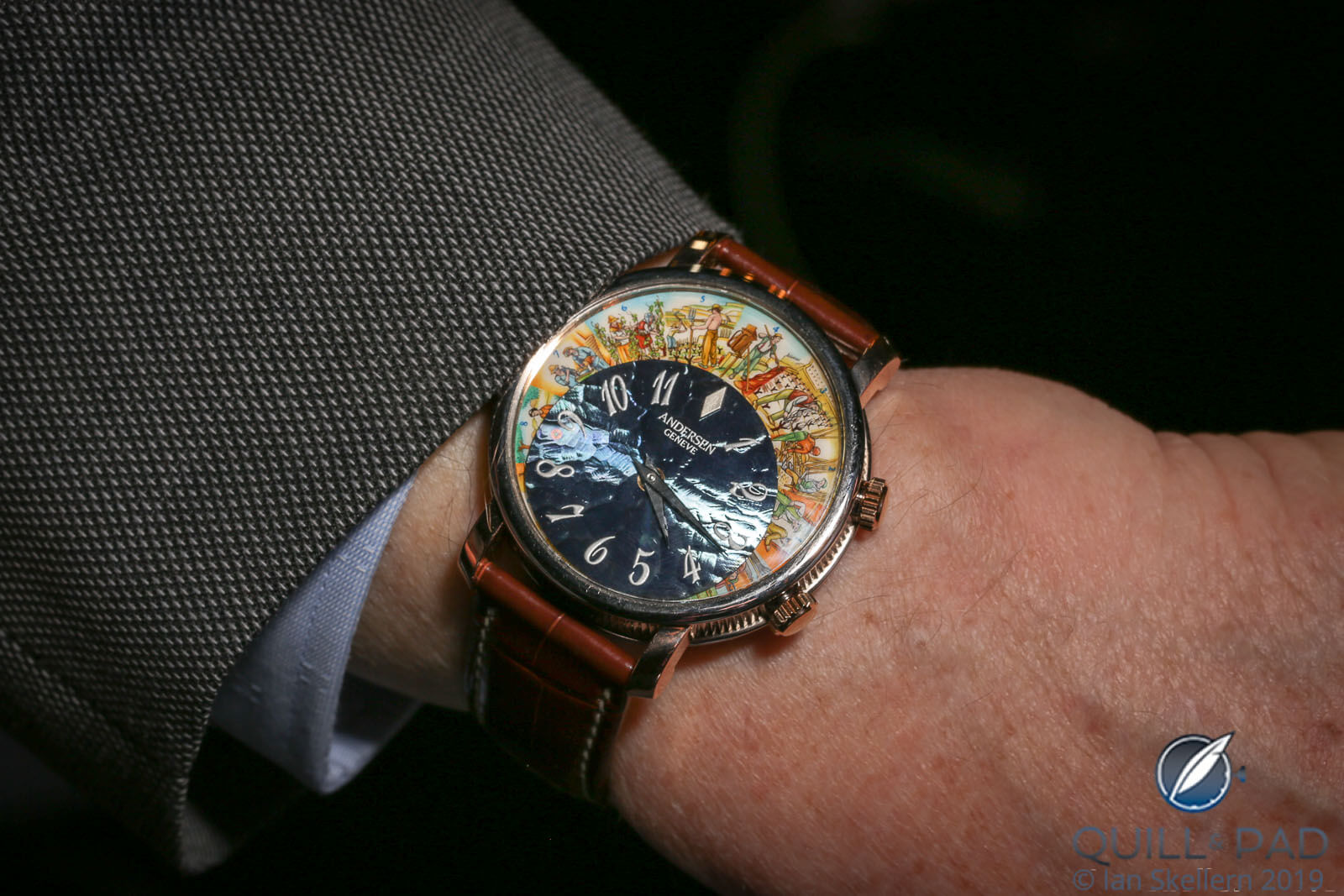
Andersen Genève Vita Vinum on the wrist
MG: I have to choose the wine because Svend Andersen is doing what he does best here: making watches that other people cannot even dream up. It is, in fact, an innovative annual calendar that focuses on what really matters: what your winemaker is doing that month! It sounds like a joke, but it is so refined, well-crafted and created, with an almost scary eye for detail, that the result is a very serious watch that gets it all right. If there were only more watchmakers of Andersen’s vintage.
IS: I love the Andersen Genève Vita Vinum (“Life Wine” in Latin). I’ve lived in a wine-growing region for decades, and both the concept and execution of the miniature rotating wine-cycle panorama is just genius. And that blue gold disk is in Andersen Genève’s “DNA”: Svend Andersen was the first to use blue gold in watch dials and has had the exclusivity of using blue gold in watches for a long time. Fantastic artwork, new indication (annual wine cycle), and even a handmade case.
For more please visit gphg.org/horlogerie/en/watches/vita-vinum.
Quick Facts Andersen Genève Vita Vinum
Case: 42.5 x 11 mm, white gold and red gold
Dial: 21-karat blue gold with hand-guilloche, miniature painting
Movement: unspecified automatic caliber, Hz/21,600 vph frequency, 36-hour power reserve
Functions: hours, minutes; month shown by 12-month rotating disk
Limitation: 12 pieces
Price: 42,800 Swiss francs
Bereve Timepieces Numbers – Enamel Grand Feu
SL: Can’t say I’ve come across this brand before, it seems quite new with a small distribution. I don’t think it’s sufficient though to say the dial was made in enamel, it still looks like one of those color perception tests and isn’t all that appealing to me (with all due respect to the artist they worked with). Simply can’t consider in present company.
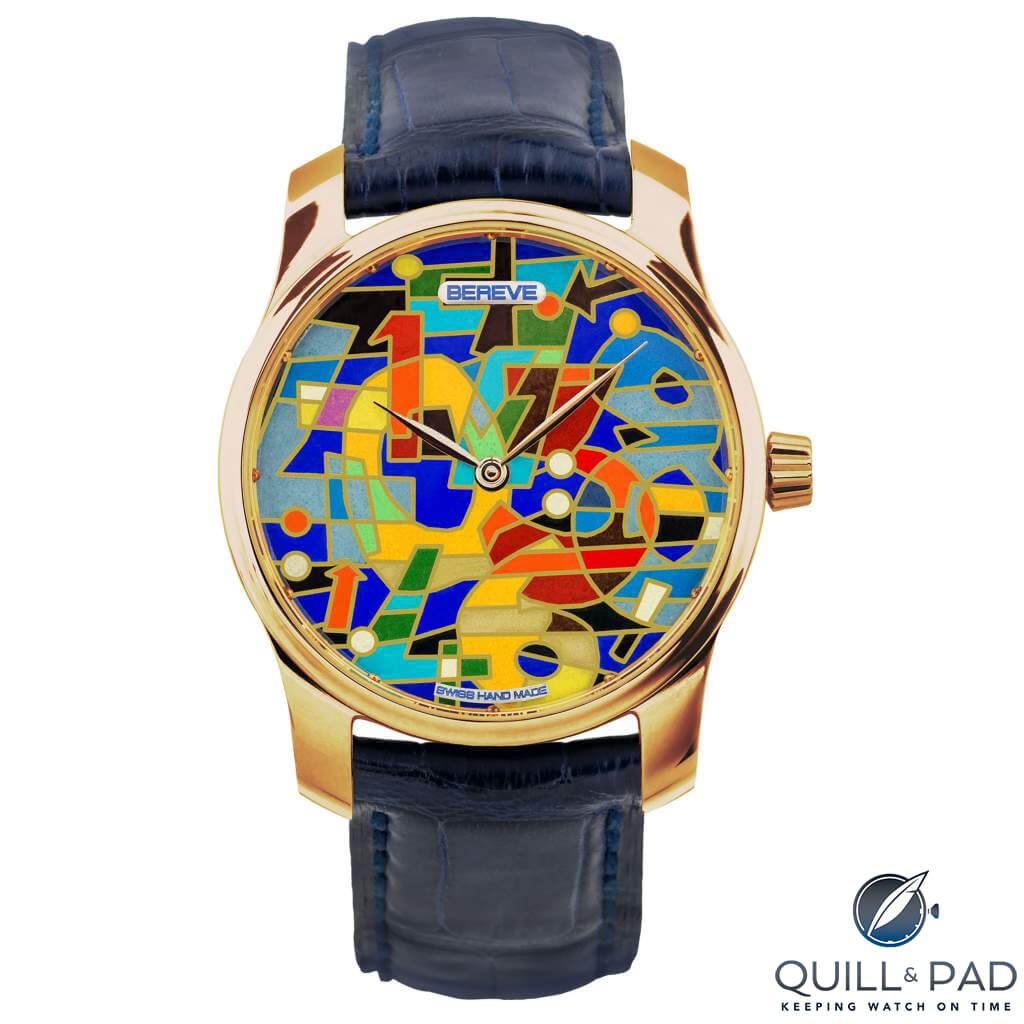
Bereve Timepieces Numbers – Enamel Grand Feu
TM: Bereve’s Numbers watch feels like a cross between Patek Philippe and peak-era Franck Muller, and I mean that as a compliment.
There’s a shade of the old Muller Crazy Hours in this dial design, but the execution is high rent. Champlevé dial engravings filled with vitreous enamel become a riot of festive numerals over more than a dozen grand feu oven exposures. For sheer time invested and craft difficulty, this watch stands out.
The Numbers watch is more interesting and inventive than any Patek Philippe 5131 or 5231, but the Artistic Crafts category is stacked with tough competition in 2019.
JM: The Bereve Numbers is a masterclass in geometric engraving combined with grand feu enamel. The entire dial is constructed out of a single piece of pure 24-karat gold that is carefully hand-engraved to create 132 individual cells filled with 20 different colors of enamel. Using a minimum of 14 individual firings for the enamel, the dial slowly takes shape as a psychedelic mashup of colors, shapes, and, as the name implies, numbers. In no other watch in the category do we see such an intense deep-dive into hand-engraved enamel and that makes it stand out for certain.
As with the Andersen Genève Vita Vinum, I think the Bereve Numbers, in spite of its incredible enamel work, doesn’t have enough of a wowza factor to take the jury in this category.

Bereve Timepieces Numbers – Enamel Grand Feu
IS: Looking at the dial I felt I was looking at one of those three-dimensional “magic eye” pictures you stared at waiting, often-forlornly and often cross-eyed, for the unseen image to pop out. The dial incorporates two arts: that of the artist who designed the dial and the enameller who made it. And there’s a beautiful Vaucher movement within.
I like it, though I also keep thinking of the Franck Muller Crazy Hours. Perhaps that’s unfair, but that reference sticks. I can’t even begin to appreciate the challenge of so many enamel firings in the oven, so many chances of something going wrong. It’s a beautiful art piece.
MG: This Bereve, which looks stunning, is one I don’t understand. Why use numbers if you don’t put them where they belong? The only watch that can get away with that is really Franck Muller with his Crazy Hours . . .
For more information, please visit gphg.org/horlogerie/en/watches/numbers-enamel-grand-feu.
Quick Facts Bereve Timepieces Numbers – Enamel Grand Feu
Case: 42 x 14 mm, red gold
Dial: oven-fired enamel
Movement: automatic Vaucher Caliber 3002, 56-hour power reserve, 4 Hz/28,800 vph
Functions: hours, minutes
Limitation: 100 pieces
Price: 27,450 Swiss francs
Chopard L.U.C XP Esprit de Fleurier Peony
SL: Chopard is a regular entrant in this category, and with good cause: the brand is certainly adept at the métiers d’art and is always capable of showing it. I’m also appreciative that the movement has also received an artistic treatment. If you look beyond the bright hues, the impact of the crafts employed is rather subtle, again, something that I rate quite highly from Chopard.
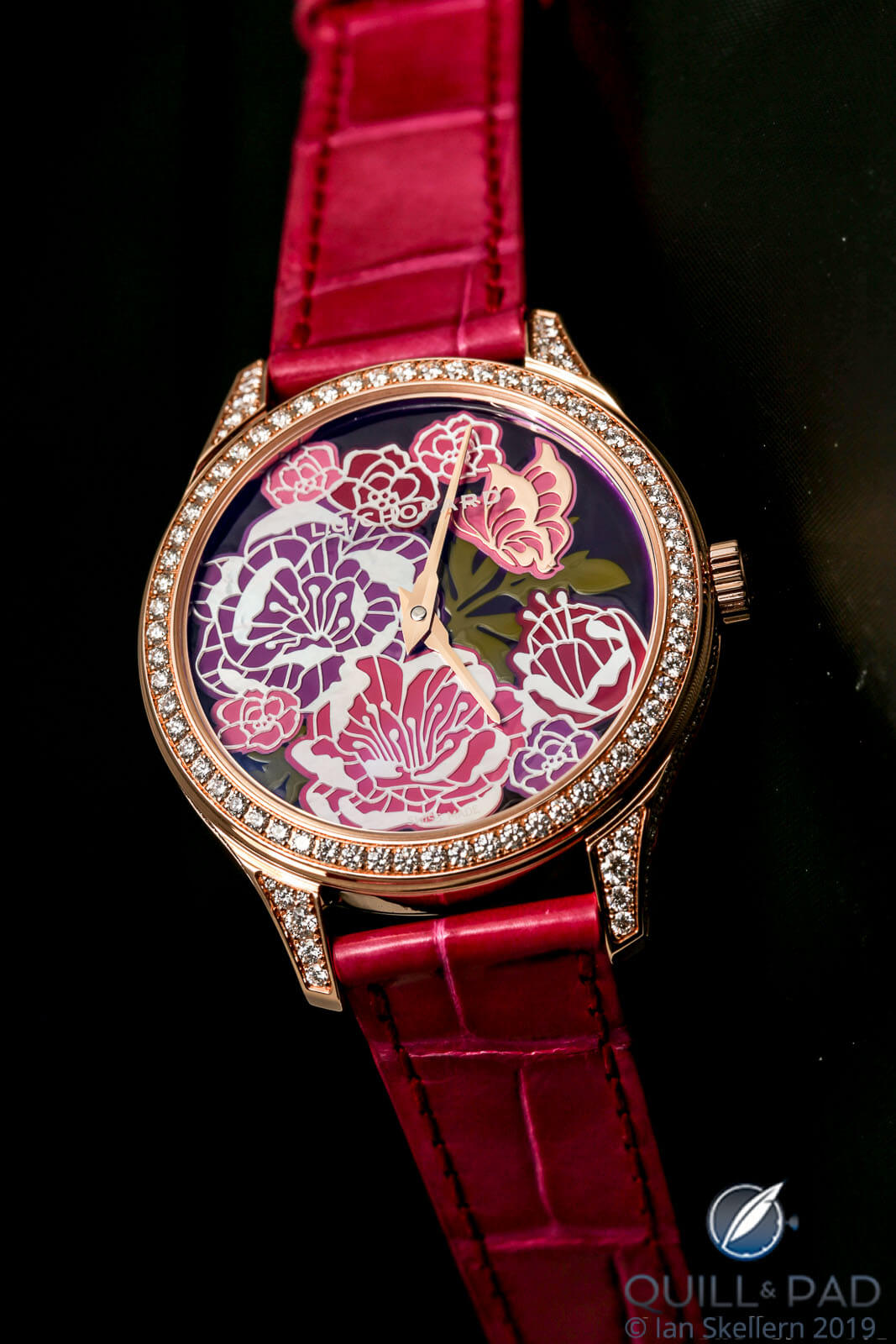
Chopard L.U.C XP Esprit de Fleurier Peony
MG: This is very delicate, yet I have seen this watch now on two occasions in the metal and it just doesn’t hit home for me. I guess that is also mainly because I love the previous versions of it so much.
IS: Chopard is a master of artistic dials, and the L.U.C XP Esprit de Fleurier Peony doesn’t disappoint. My first impressions were (in this order): 1) L.U.C, very nice movement; 2) wow, that’s some bright red; and 3) the patterns and colors on the dial work for me. Impressively, the scintillating diamond-set red gold case and bright-red strap complement the dial nicely. Less bold colors on the dial could easily have led the eye to the case and strap, but that dial more than holds its own. Another stunning wristwatch.
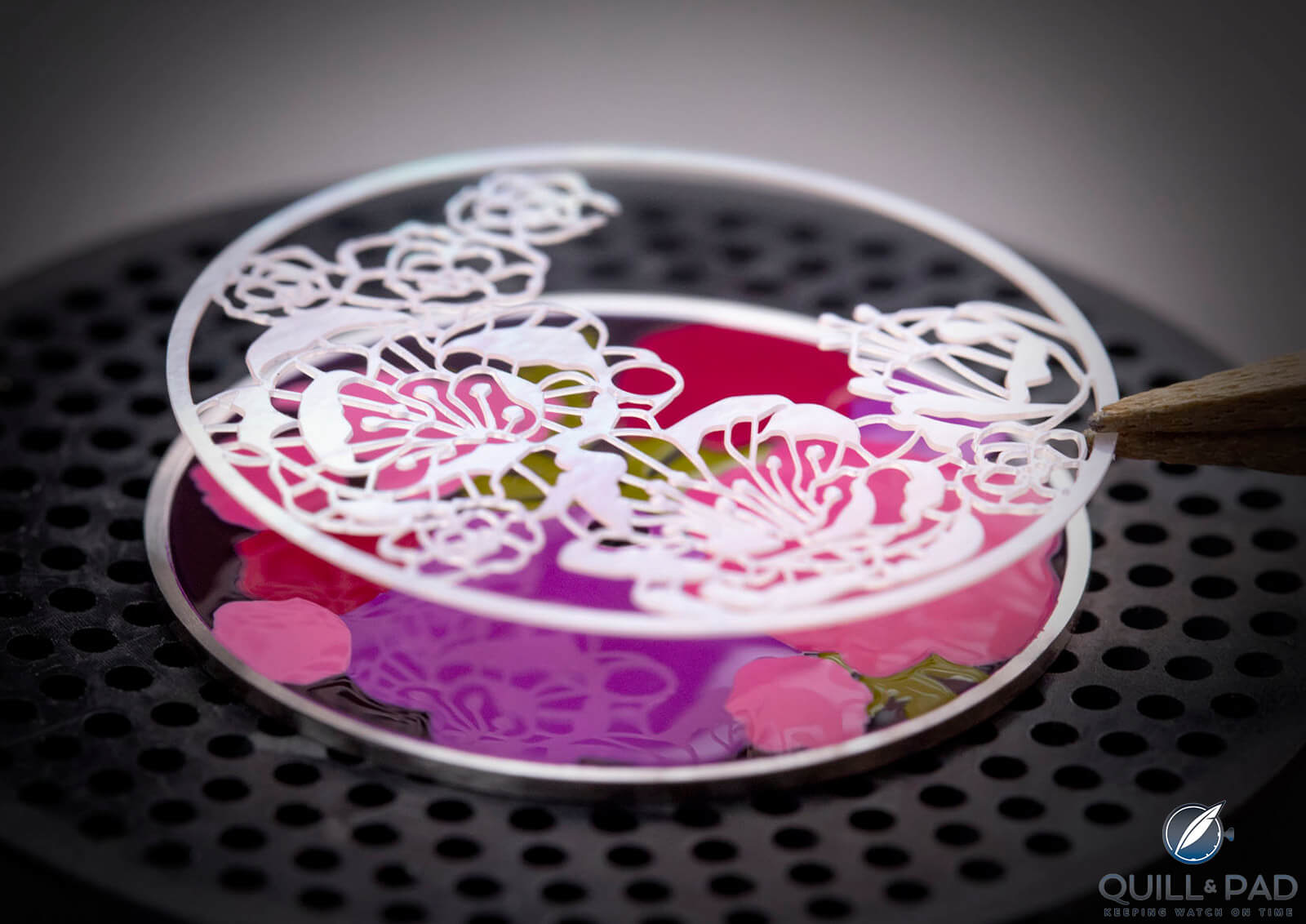
Assembling the multi-layered dial of the Chopard L.U.C XP Esprit de Fleurier Peony
JM: The Chopard L.U.C XP Esprit de Fleurier Peony is a stunning example of mother-of-pearl marquetry mixed with a variety of finishes to create beautiful flowers that feel like they are leaping off the dial. The motif even continues on the rear of the watch with a fully engraved movement reflecting the beauty inside and out. And it isn’t enough. The artistic crafts category is tough for this very reason: the Esprit de Fleurier Peony is a marvelous and beautiful watch that, on any other day, is the highlight of the room.
But when placed next to all of these watches, it becomes a middle-of-the-road piece. A genius in a room of geniuses probably won’t be the smartest, and this is the only reason I can see that the Esprit de Fleurier Peony may not take the top spot. It feels overshadowed by some of its peers.
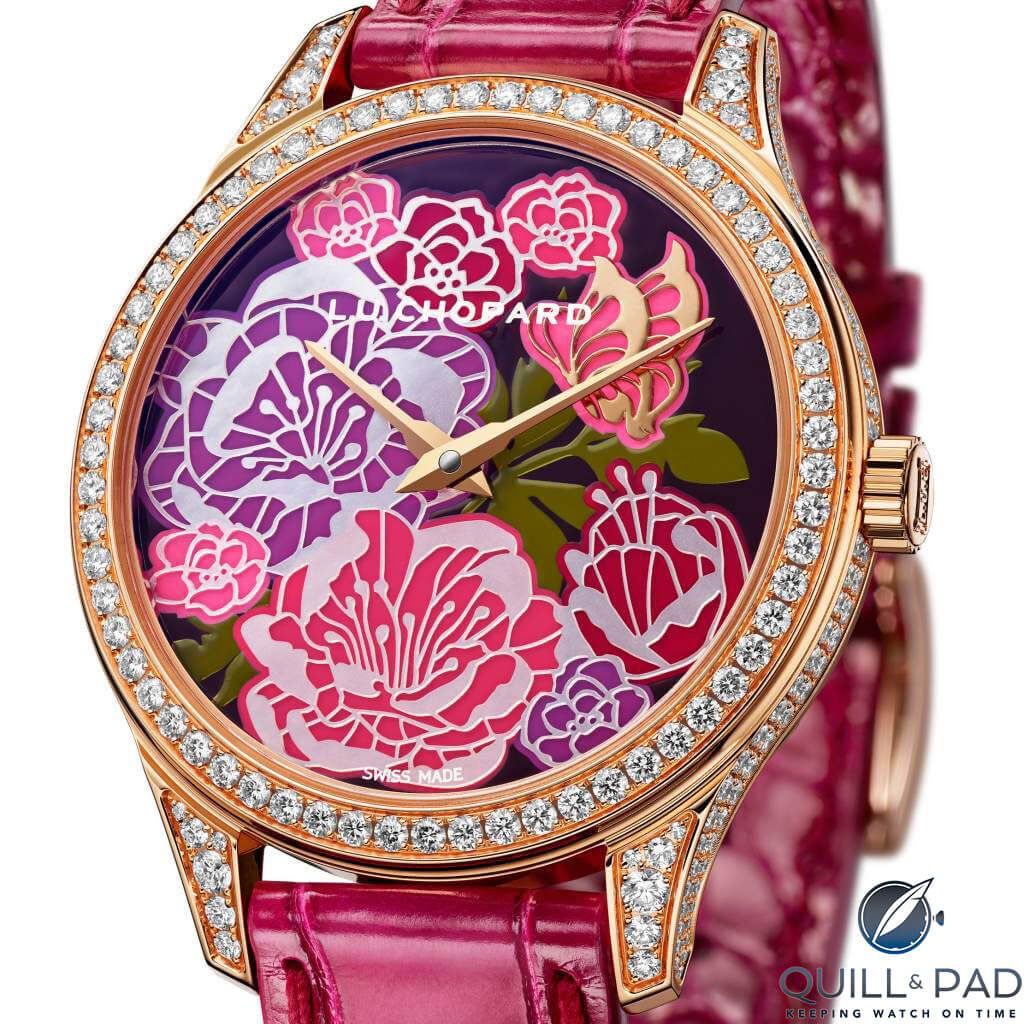
Chopard L.U.C XP Esprit de Fleurier Peony
TM: Chopard’s L.U.C XP Esprit de Fleurier Peony stands among the most wearable and intricate of this year’s entrants. At 35 mm in diameter, this is one dense little canvas: miniature painting, gold appliqué, and precision-cut mother-of-pearl achieve a handsome three-dimensional depth that belies the 7.7 mm thickness of the watch. Colors are distinct, strong, and mutually coherent given the floral theme. If a tastefully rendered pink flower watch is your idea of the ultimate quasi-bespoke accessory, then this eight-piece series is for you.
For more information, please visit gphg.org/horlogerie/en/watches/luc-xp-esprit-de-fleurier-peony-0.
Quick Facts Chopard L.U.C XP Esprit de Fleurier Peony
Case: 35 x 7.7 mm, pink gold, diamond setting
Dial: hand-cut mother-of-pearl appliqués, Fleurisanne hand-engraving
Movement: automatic L.U.C Caliber 96-23-L with micro rotor, Twin technology (two sets of stacked spring barrels), power reserve 65 hours, 3 Hz/21,600 vph frequency
Functions: hours, minutes
Limitation: 8 pieces
Price: 93,000 Swiss francs
Hermès Arceau Baobab Cat
IS: Hermès has long been a world leader in artistic dials and a big supporter of exceptionally talented artists. So it’s no surprise that the imagery, colors, and even the storytelling of the leopard in the baobab are all so artfully executed. What is surprising is how playful the painting is: this dial would make any child, and even some of us older children, smile.
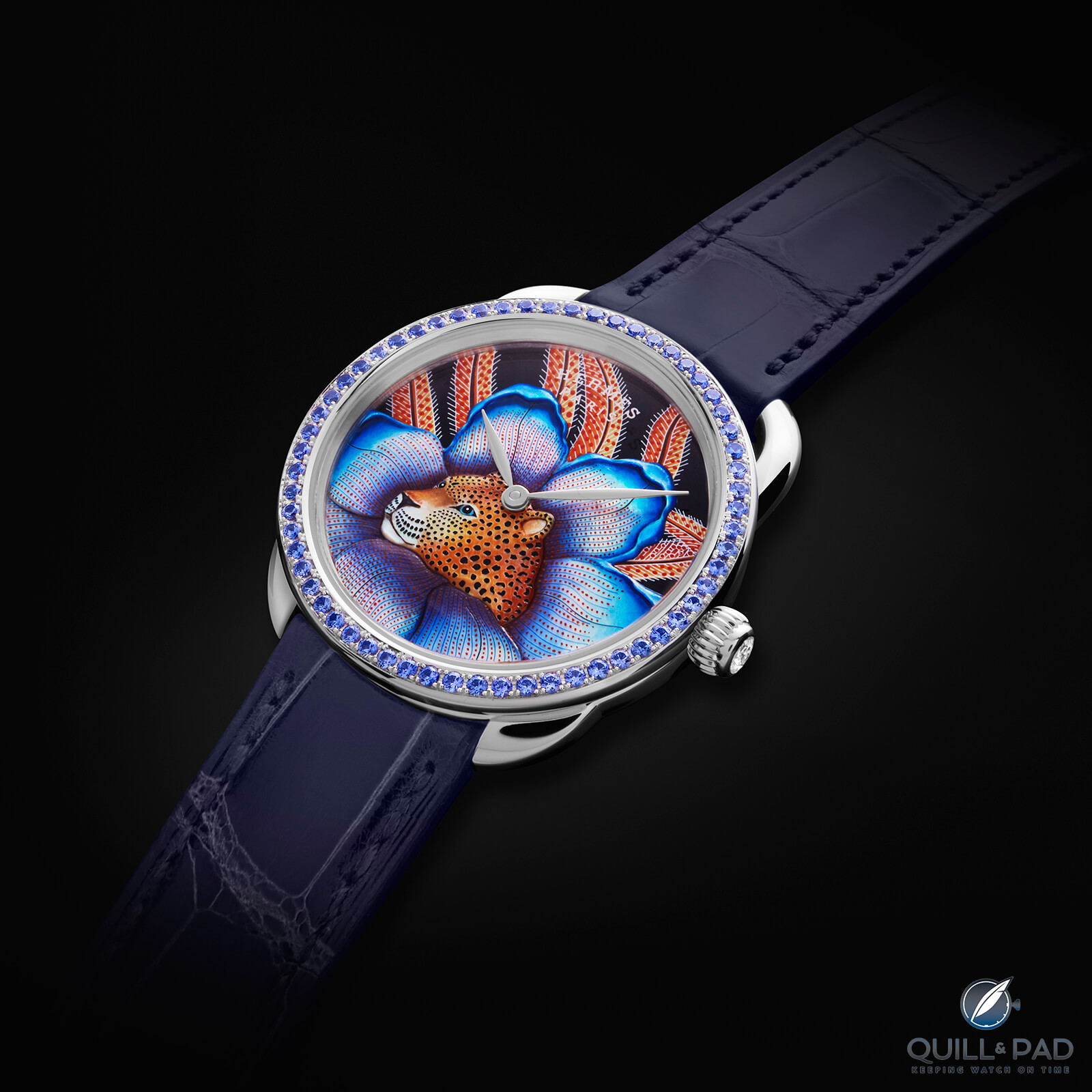
Hermès Arceau Baobab Cat
SL: Hermès is also regularly seen in the Artistic Crafts shortlist, with good reason. And I understand that this particular design comes from one of its well-known silk scarves. It’s brought to life very well on the dial, with a clever use of different materials to give the graphic some texture. But I have to be honest: it comes across as a bit odd on a watch dial.
TM: Hermès counters its competition with a watch that doubles as a rebus for “carnivorous plant.” Joking aside, this subject matter is odd in combination but attractive in execution.
The Arceau Baobob Cat’s miniature painting is colorful, florid, and appealing. Mother-of-pearl provides a suitably delicate base for the brush strokes, and the 34 mm case size renders all of the above an impressive feat of micro-precision. Shading around the center of the flower is of particular quality; it imparts the appearance of depth where none exists.
Hermès’ specific choice of a spotted cat seems odd given the universal association of the like with Cartier. Sure, we can quibble about which species is depicted by whom, but big wild cats are Cartier’s turf. Otherwise, this watch is handsome, wearable, and impressively intricate. The nuances of the image derived from a delicate touch and a deft eye for color. Brilliant-cut blue sapphires in the bezel do an excellent job of setting off the blue tones of the dial.
Some of the watches in this category are absurd ringers for the Artistic Crafts prize. In contrast, the compact Hermès could be worn daily to an office without making an obnoxious statement of personal wealth or status.
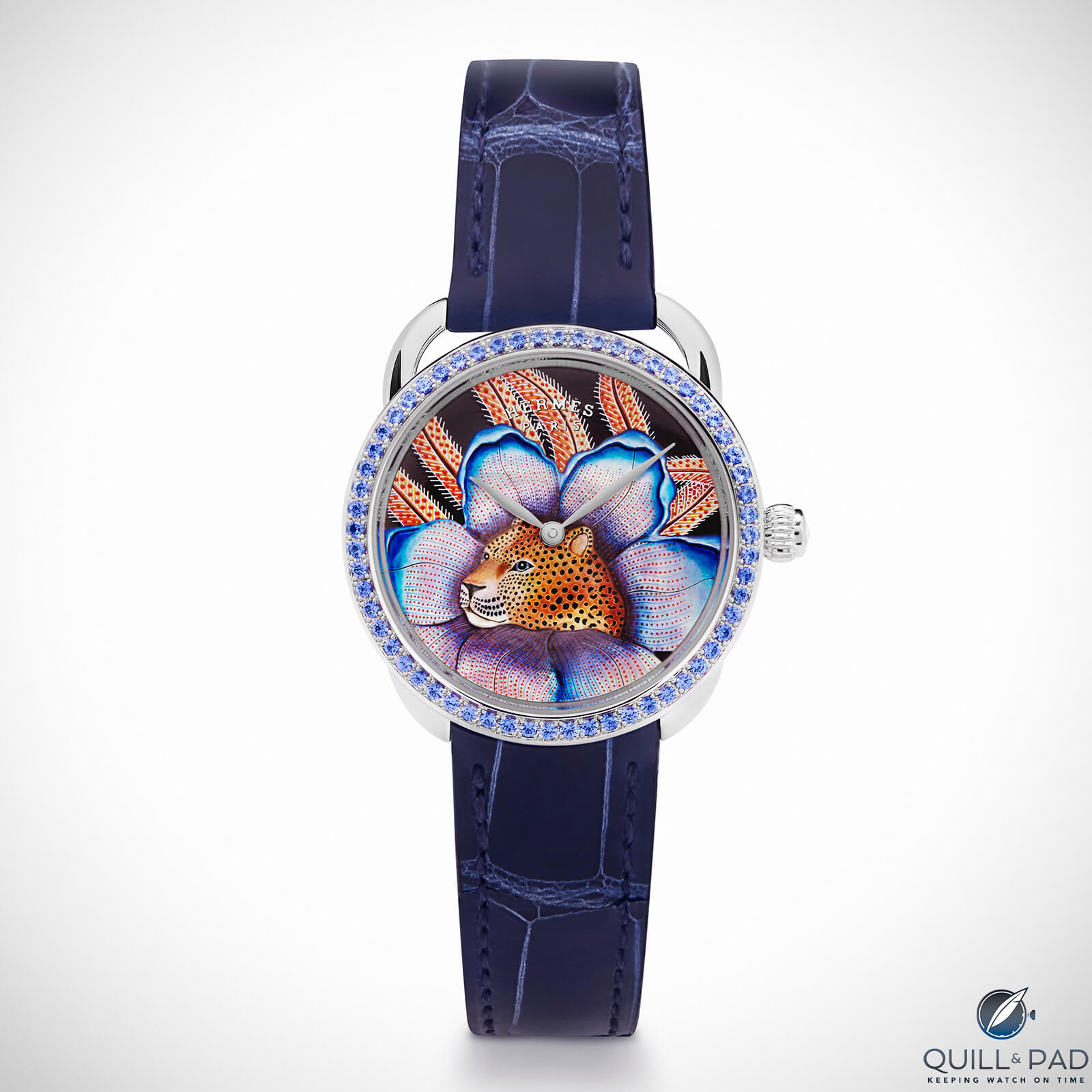
Hermès Arceau Baobab Cat (photo courtesy Hermès/Gilles Pernet)
JM: This piece suffers the same fate, I fear, as the Chopard Esprit de Fleurier Peony by being a truly gorgeous watch that demonstrates mastery over miniature painting and mother-of-pearl engraving yet fails to make a bold impact. It’s a tough world when such a lovely watch has a hard time making a splash. I love the colors and vibrancy, not to mention the slightly surrealist image surrounded by a ring of blue-tinged diamonds. As awesome as this piece is, though, I am worried it will get lost in the shuffle and not make it on most jury members’ shortlist.
For more information, please visit gphg.org/horlogerie/en/watches/arceau-baobab-cat.
Quick Facts Hermès Arceau Baobab Cat
Case: 34 x 9.45 mm, white gold
Dial: mother-of-pearl miniature painting, hand-engraving
Movement: automatic Caliber H1912, 4 Hz/28,800 vph frequency, power reserve 50 hours
Functions: hours, minutes; power reserve display
Limitation: 12 pieces
Price: 83,000 Swiss francs
Jacob & Co. Astronomia Dragon
JM: Jacob & Co. is always bold, so this watch almost comes as no surprise with the incredibly detailed, fully three-dimensional, hand-engraved white gold dragon wrapping gracefully around the Astronomia double-axis tourbillon mechanism. The entirely unique engraving process needed three months to create all of the sections that would combine to create the dragon that protects the movement.
No other watch in this category even comes close to the hand-engraving on this piece, and I would not be surprised if it won the category. I personally like another watch more than this one and so it isn’t my chosen winner, but the jury may very well come together to raise this one above the rest. If it doesn’t, I think it will end up going for my chosen winner instead.
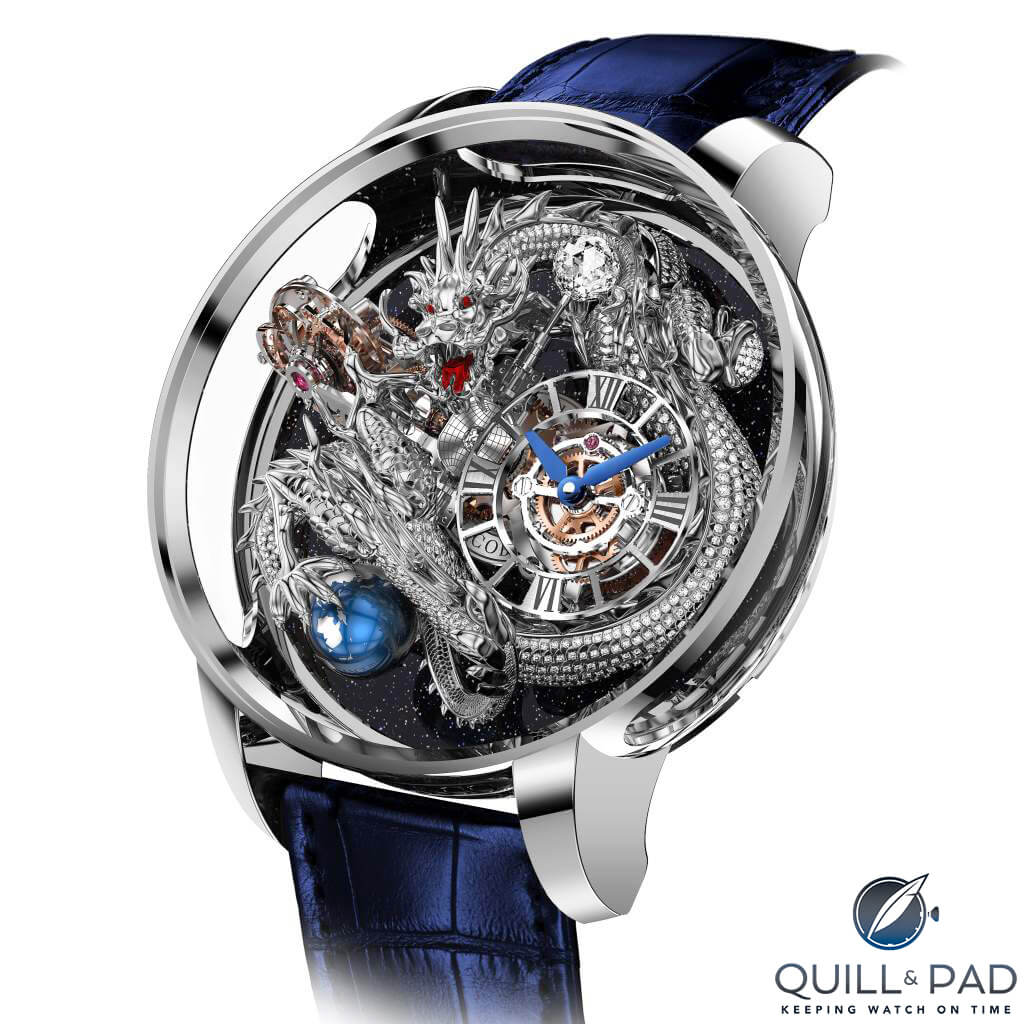
Jacob & Co. Astronomia Dragon
TM: Jacob & Co. stacked the deck with three entries in this year’s pre-selection. Of the three, this Astronomia Dragon is the middle prospect; it has a better claim to its category than the Jardin of the Ladies category, but it isn’t the clear category leader like the Mystery Tourbillon in the Jewellery category.
Dragon sculpture watches are becoming a thing – Cabestan, Vacheron Constantin, and Richard Mille were here first – but the Astronomia Dragon is the richest and most impressively detailed canned creature in this burgeoning class. A three-dimensional white gold dragon sculpture is the centerpiece. Set gems provide additional definition to the hand-formed gold serpent, and the result feels rich without becoming a parody of itself.
Richard Mille, take note: this is how you do a serpent watch without drawing unintentional laughs. Due to the bold volumes and gossamer tapers of this dragon, its value as three-dimensional art sets it apart from its flat rival watches in the 2019 GPHG Artistic Crafts category.
SL: If this watch were smaller, I’d probably be greatly impressed by it. It’s not to say that I’m not, but at 50 mm it’s again a rather large piece. I almost would’ve preferred it to go larger, to create a tabletop clock, instead of a watch that seems unwieldy and almost overshadows the artists skills in bringing it to life.
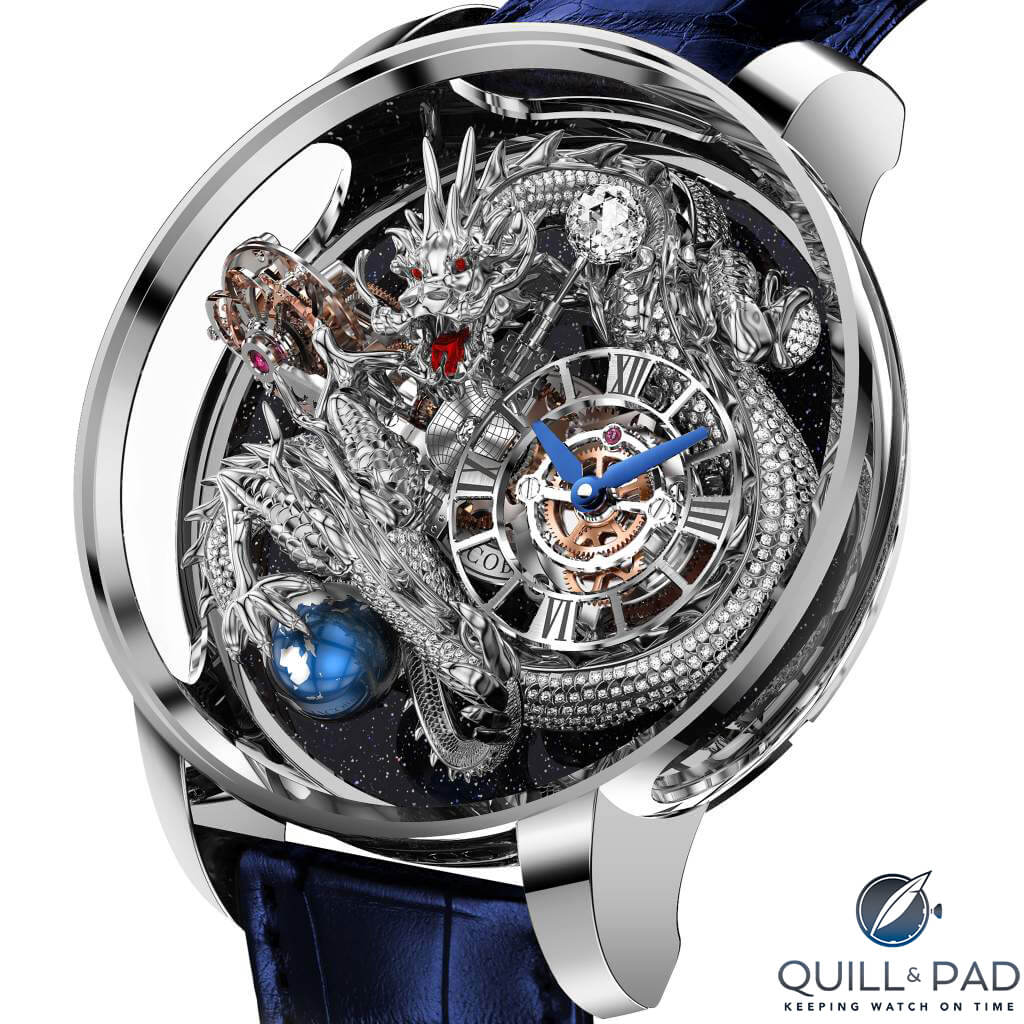
Jacob & Co. Astronomia Dragon
IS: I infer from the name of the Artistic Crafts category that as “judges” we should be placing more emphasis on the art than the horology, but with the Jacob & Co. Astronomia Dragon the double-axis tourbillon planetary horology is a piece of art in itself. The massive domed crystal pulls the viewer into another world.
As a practical wristwatch, the 50 mm case diameter rules it out for all but a few. But as a showcase, a whole boutique for displaying art, it’s absolutely perfect. Whether or not the engraved dragon is your cup of tea, the art is undeniable, the horology sublime, and the setting majestic. And all that to say that the Astronomia is my runner-up.
Note: just this one photo (and a crop) to showcase the most complex three dimensional watch in the competition? Come on, Jacob & Co, it deserves better than that.
MG: The Astronomia is fun enough, but as I am very European and dragons are not part of our culture, the significance is lost and it is very quickly out of place.
Further reading:
Jacob & Co Astronomia Tourbillon Baguette: A Universe On The Wrist
For more information, please visit gphg.org/horlogerie/en/watches/astronomia-dragon.
Quick Facts Jacob & Co. Astronomia Dragon
Case: 50 x 25.45 mm, white gold
Dial: hand-sculpted 18-karat white gold dragon with rubies for eyes
Movement: manual winding Caliber JCAM16 with double-axis tourbillon and patented differential gear system, 3 Hz/21,600 vph frequency, 60-hour power reserve, featuring a one-carat 288-facet spherical Jacob-cut diamond Functions: hours, minutes
Price: 1,077,000 Swiss francs
Voutilainen Starry Night Vine
SL: Kari Voutilainen has developed a real knack for these kinds of artistic craft watches. I believe he’s actually won this category twice before as well, and with this latest entry, I’d say he’s well on his way to winning it again. It’s unusual to have three very different artists collaborate on one piece, yet it somehow comes together quite well in this piece, even if the three themes don’t have much in common. The choice of colors and patterns ultimately works.
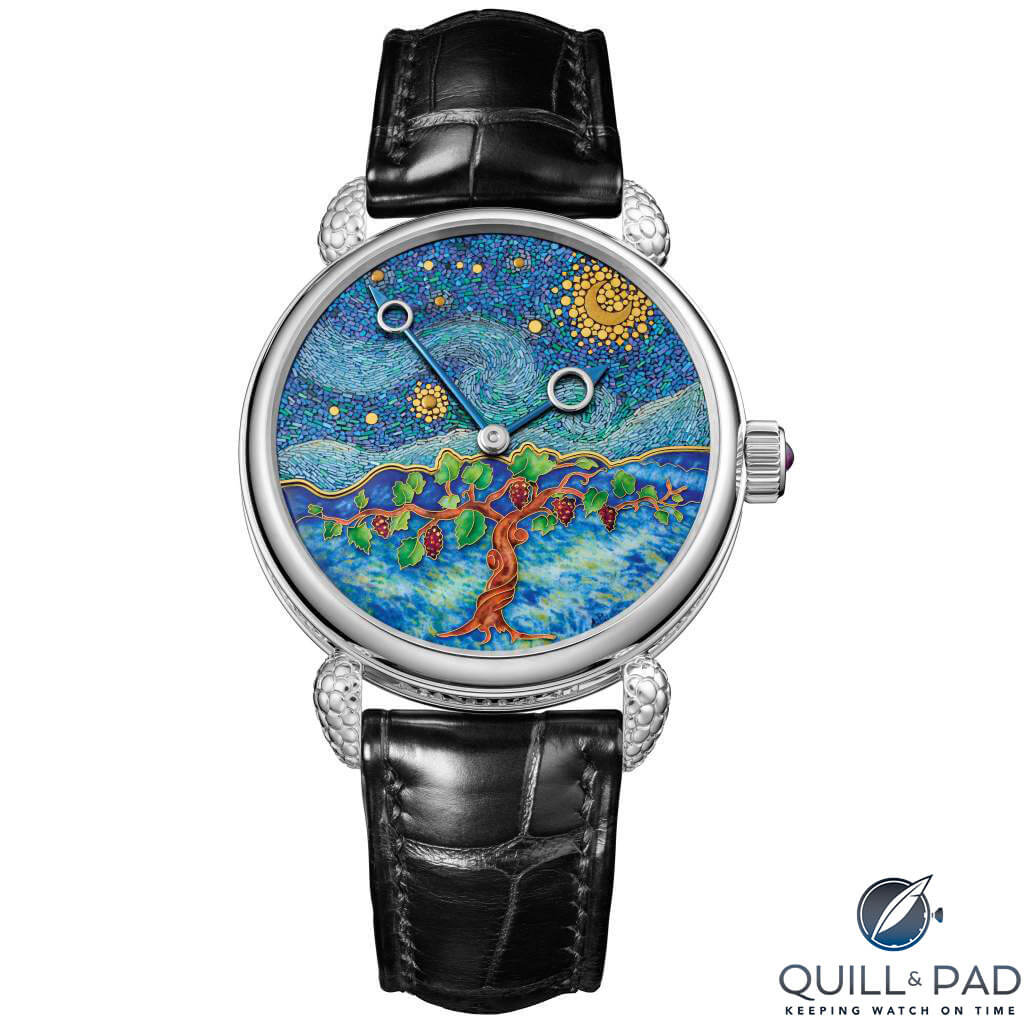
Voutilainen Starry Night Vine
JM: Of course my winner is the Voutilainen! Is there any independent watchmaker who continues to produce such astonishing displays of artistic crafts as Kari Voutilainen? Perhaps, but it isn’t readily apparent and every edition of the GPHG tends to demonstrate this fact. Of course, I feel like Voutilainen is a shoo-in and has had titles in the past for equally impressive works of art, so I wouldn’t be surprised if he was passed over simply to let someone else win (politics still exist).
Still, with the immaculate execution of micro marquetry by Japanese artist Tatsuo Kitamura in combination with cloisonné enamel from Anita Porchet, the skills demonstrated in this watch are second to none. Even though every other watch in the category is incredibly beautiful, the Voutilainen Starry Night Vine is a cut above the rest.
TM: Kari Voutilainen likely needs no more accolades or award hardware, but I predict that he will – or at least should – add to the trophy shelf. The Voutilainen Starry Night Vine is a collaborative masterpiece.
Voutilainen himself provides the hardware. Enamel legend Anita Porchet, co-recipient of the 2017 GPHG Special Jury Prize, handles the lower-half “vineyard” imagery. Previous Voutilainen collaborators Tatsuo Kitamura (lacquer) and Eddy Jaquet (engraving) complete the “starry” sky and grape-themed case engravings respectively. As with the Chopard and Hermès entries, the Voutilainen is a dense mass of invention: 39 mm is a tiny canvas for this much original artwork.
Voutilainen’s four-way alliance is a triumph. Kitamura channels Van Gogh with virtuoso effect; the intensity and luminous magic of the oil-paint original. Engraving grape imagery into the case wasn’t necessary to put this watch over the top, but I’m glad it was done.
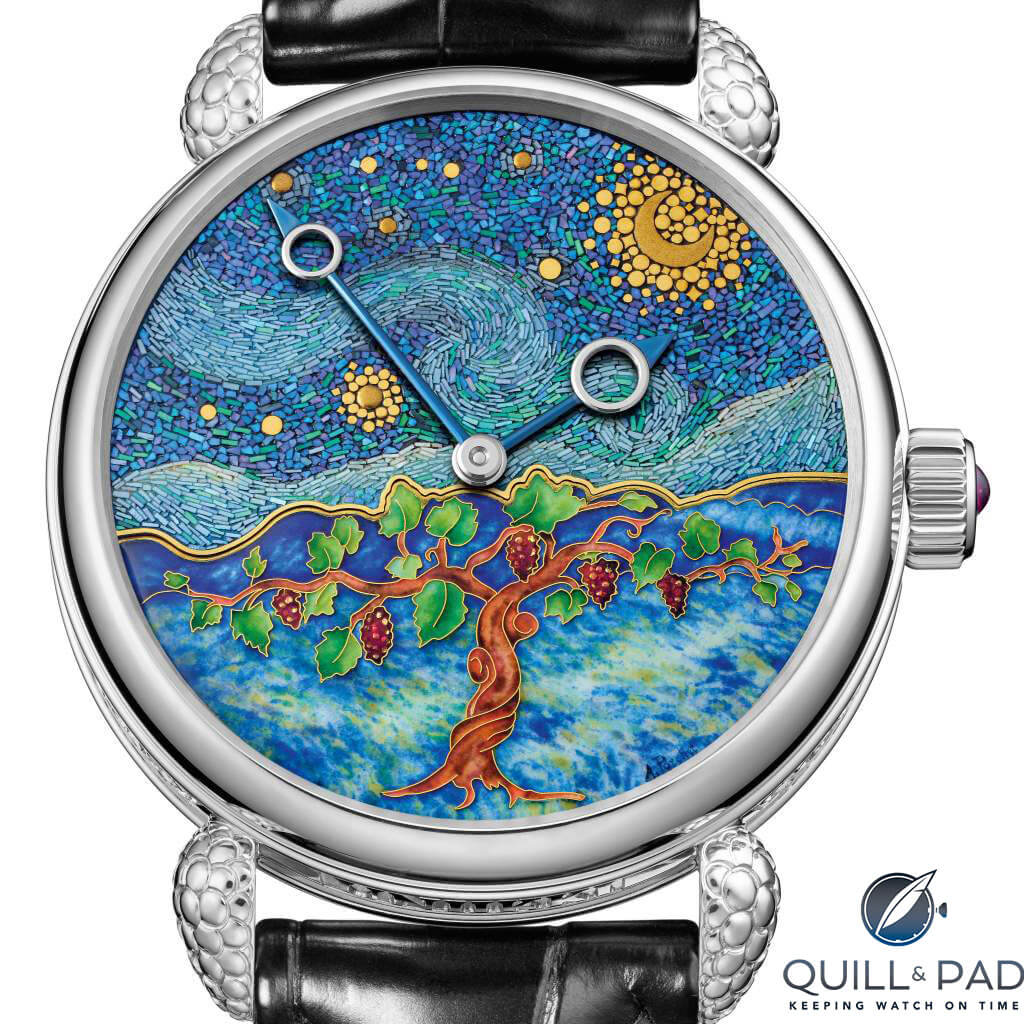
Voutilainen Starry Night Vine
MG: I am absolutely in love with the Starry Night Vine by Voutilainen.
IS: I’d like the GPHG to promote and encourage new concepts, ideas, and thinking; to encourage them to be exceptional rather than getting a pat on the back for what they were doing anyway, i.e., repeating/revisiting the past. So in my GPHG choices, I’m biased against watches I’ve seen over and over again, and even appearing multiple times — with different makeup — in different categories in the same year. And I know that this is because the base models are just so good and/or so popular that it’s unfair to penalize true icons.
I’m talking about watches like the Zenith El Primero. And Now Kari Voutilainen. As with the Zenith El Primero, an industry legend over many decades, Voutilainen, a niche independent watchmaker,”‘feels” like it gets pre-selected in multiple categories each year. Familiarity brings boredom, wake me up with something new.
Yes, I know that Voutilainen’s movements are divine, created by horological angels (with loupes), and delivered in sparkling stardust to customers. And to my eyes, his teardrop-lugged case is teardrop-dead gorgeous. But I’ve seen it all before. Not so often that I don’t dream of owning a Voutilainen one day, but it’s time to move on.
And then BAM! I see the Starry Night Vine, my heart speeds up, my legs go rubbery, and I smile. As an exceptional work of art seamlessly complemented by its horological setting, the Starry Night Vine is simply perfect.
Why this is my hands-down winner.
- movement: 10/10
- case and lugs not set with diamonds as might be expected but hand-engraved leaves and grapes: 10/10
- dial displaying artwork by two different artists on different continents and from different cultures, different sexes, different languages, different mediums of expression, all blending seamlessly as one: 10/10
- artwork leaps off the dial, the case is the perfect frame: 10/10
The Voutilainen Starry Night Vine is not only an exceptional work of art, it’s a work of art I’d happily wear on my wrist.
For more information, please visit gphg.org/horlogerie/en/watches/starry-night-vine.
Quick Facts Voutilainen Starry Night Vine
Case: 39 x 12.8 mm, white gold, case engraving by Eddy Jaquet
Dial: lacquer technique by Tatsuo Kitamura comprising Kinpun (gold dust), Jyunkin-itakane (gold leaf), Yakou-gai (green turban sheel), and Awabi-gai (New Zealand abalone shell) along with enamel by Anita Porchet
Movement: manual winding Voutilainen caliber, 3 Hz/18,000 vph frequency, power reserve 65 hours
Functions: hours, minutes; power reserve
Limitation: one unique piece
Price: 248,000 Swiss francs
Predicted Winners:
Martin: Andersen Genève Vita Vinum
Tim: Voutilainen Starry Night Vine
Sean: Voutilainen Starry Night Vine
Joshua: Voutilainen Starry Night Vine
Ian: Voutilainen Starry Night Vine
You may also enjoy:
Our Predictions In The Ladies Category Of The 2019 Grand Prix d’Horlogerie de Genève (GPHG)
Our Predictions In The Chronograph Category Of The 2019 Grand Prix d’Horlogerie de Genève (GPHG)
Leave a Reply
Want to join the discussion?Feel free to contribute!





















































The theme from ‘The Spy Who Loved Me’ is playing in my head.